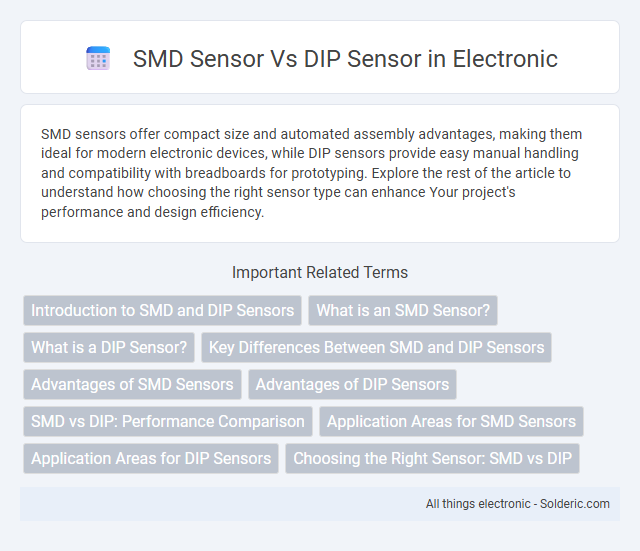SMD sensors offer compact size and automated assembly advantages, making them ideal for modern electronic devices, while DIP sensors provide easy manual handling and compatibility with breadboards for prototyping. Explore the rest of the article to understand how choosing the right sensor type can enhance Your project's performance and design efficiency.
Comparison Table
| Feature | SMD Sensor | DIP Sensor |
|---|---|---|
| Mounting Type | Surface Mount Device (SMD), mounted directly on PCB surface | Dual In-line Package (DIP), inserted into through-hole PCB |
| Size | Compact, smaller footprint for high-density boards | Larger, bulkier due to through-hole pins |
| Installation | Automated pick-and-place, suitable for mass production | Manual or machine insertion, slower process |
| Durability | Good mechanical strength but sensitive to board flexing | High mechanical strength, robust under physical stress |
| Cost | Lower manufacturing cost for large volumes | Higher cost due to labor and materials |
| Performance | Suitable for high-frequency and precision sensing | Reliable, but limited for high-speed applications |
| Applications | Consumer electronics, compact devices, automotive sensors | Prototyping, industrial, educational kits |
Introduction to SMD and DIP Sensors
SMD sensors (Surface Mount Device) are designed for compact, automated assembly on printed circuit boards (PCBs), offering high precision and space-saving advantages in modern electronics. DIP sensors (Dual In-line Package) feature through-hole mounting with pins inserted into PCB holes, providing robust mechanical stability and ease of manual installation. Your choice between SMD and DIP sensors should consider device size, assembly method, and application-specific performance requirements.
What is an SMD Sensor?
An SMD sensor, or Surface-Mount Device sensor, is a type of electronic sensor designed for direct mounting onto the surface of printed circuit boards (PCBs) using automated soldering techniques. These sensors are compact, lightweight, and enable high-density component placement, leading to enhanced performance in miniaturized electronic devices. Compared to DIP (Dual In-line Package) sensors, SMD sensors offer improved electrical characteristics, reduced parasitic inductance, and compatibility with modern manufacturing processes.
What is a DIP Sensor?
A DIP sensor refers to a Device In Package sensor designed with discrete components mounted through holes on a printed circuit board (PCB), offering robust mechanical connections and ease of replacement. Unlike Surface-Mount Device (SMD) sensors, DIP sensors feature pins that pass through the PCB, enabling stable electrical contact suitable for high-reliability applications. Commonly used in industrial and automotive environments, DIP sensors provide durability and straightforward integration into legacy systems.
Key Differences Between SMD and DIP Sensors
SMD sensors are compact surface-mounted devices designed for automated PCB assembly, offering higher density and better performance in miniature electronics, while DIP sensors feature through-hole pins suited for manual insertion and prototyping. The main differences include their mounting technology, size, and application scope, with SMD sensors enabling more complex, space-saving circuits compared to the larger, more robust DIP sensors. Your choice depends on circuit design requirements, production volume, and reliability needs.
Advantages of SMD Sensors
SMD sensors offer significant advantages over DIP sensors, including a more compact design that allows for higher component density and more efficient use of PCB space. Their surface-mount technology enables automated assembly processes, reducing production costs and increasing manufacturing speed. You benefit from enhanced performance reliability and improved thermal management, making SMD sensors ideal for modern electronic devices.
Advantages of DIP Sensors
DIP sensors offer enhanced durability and ease of handling during manual assembly due to their through-hole design, making them ideal for prototyping and low-volume production. Their robust construction provides better mechanical stability and reliability in harsh environments compared to SMD sensors, which are more vulnerable to physical stress. DIP sensors also allow straightforward replacement and testing, simplifying maintenance and troubleshooting in electronic devices.
SMD vs DIP: Performance Comparison
SMD sensors offer superior performance over DIP sensors due to their smaller size, which allows for higher precision and faster response times in compact electronic applications. DIP sensors, though more robust and easier to handle during prototyping, generally provide lower accuracy and slower signal processing compared to SMD sensors. The integration of SMD sensors in modern circuits enhances overall system efficiency by enabling higher component density and improved thermal management.
Application Areas for SMD Sensors
SMD sensors are widely used in compact electronic devices, automotive systems, and wearable technology due to their small size and efficient surface mount design. Their applications include temperature monitoring in smartphones, motion detection in drones, and environmental sensing in IoT devices. The high integration capability of SMD sensors makes them ideal for mass production in consumer electronics and industrial automation.
Application Areas for DIP Sensors
DIP sensors are widely used in industrial automation and embedded systems due to their robust design and ease of handling during manual assembly. These sensors are ideal for applications requiring through-hole mounting on printed circuit boards (PCBs), such as automotive electronics, consumer appliances, and power management systems. Their compatibility with standard breadboards and prototyping setups also makes them favorable for educational and development projects.
Choosing the Right Sensor: SMD vs DIP
Choosing the right sensor depends on your project's size, mounting requirements, and performance needs. SMD (Surface-Mount Device) sensors offer compact size and suitability for automated PCB assembly, making them ideal for high-density applications and modern electronics. DIP (Dual In-line Package) sensors provide easier manual handling and prototyping flexibility, which can be beneficial for initial development stages or repair tasks.
SMD sensor vs DIP sensor Infographic

 solderic.com
solderic.com